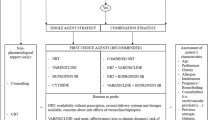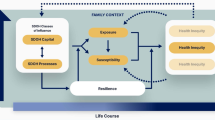Abstract
Purpose
The Japanese male smoking prevalence is still high. Underlying causes are the low quit attempt rate (QAR) and lack of pharmacotherapy (PT) use. Though health checkups are widely and systematically performed in Japan, this setting has not been utilized for intervention to smokers. We aimed to estimate the population effect of disseminating brief intervention (BI) at health checkup facilities combined with encouraging PT utilization.
Methods
The annual population quit rate (PQR) was modeled as a product of three components: the QAR, utilization of PT, and effectiveness of PT. A policy to disseminate effective BI at health checkup facilities was then incorporated into the PQR model as means to increase the QAR and/or PT utilization. Japanese male smokers aged 40–74 years were the target population, and the baseline year was set at 2005. The PQR and the number of smokers who successfully quit were compared with the baseline to evaluate the BI policy.
Results
The BI policy was estimated to increase the PQR from 4.3 to 5.7 % (rate ratio: 1.34) in a scenario where 75 % of smokers having an annual health checkup received BI and 60 % of BI-induced quit attempts were supported by PT, resulting in 177,000 new successful quitters on an annual basis and 3,000 avoidable cancer deaths in 10 years. Comparisons of different scenarios revealed that increasing QAR and encouraging PT were both essential to maximize the effect of BI policy.
Conclusion
The dissemination of BI at health checkup facilities encouraging PT utilization is an effective tobacco control policy in Japan.


Similar content being viewed by others
Abbreviations
- BI:
-
Brief intervention
- OTC:
-
Over-the-counter
- PQR:
-
Population quit rate
- PT:
-
Pharmacotherapy
- QAR:
-
Quit attempt rate
- Rx:
-
Prescription
References
Thun MJ, DeLancey JO, Center MM, Jemal A, Ward EM (2010) The global burden of cancer: priorities for prevention. Carcinogenesis 31:100–110
(2008) Adult smoking prevalence (National Health and Nutrition Survey). http://www.health-net.or.jp/tobacco/product/pd100000.html. Accessed 4 Jan 2010 [Japanese]
(2009) WHO report on the global tobacco epidemic, 2009: implementing smoke-free environments. http://www.who.int/tobacco/mpower/en/. Accessed 1 Dec 2010
(2006) National Cancer Institute and Centers for Disease Control and Prevention Co-sponsored Tobacco Use Special Cessation Supplement to the Current Population Survey (2003). http://riskfactor.cancer.gov/studies/tus-cps/results/data03/table1.html. Accessed 1 Dec 2010
Nakamura M (2009) Research on the system development and dissemination of the effective support for smoking cessation, 2008 Annual report. Grants-in-aid for the Third-Term Comprehensive Ten-Year Strategy for Cancer Control from the Ministry of Health, Labour, and Welfare, Japan [Japanese]
(2008) Clinical practice guideline treating tobacco use and dependence 2008 update. http://www.surgeongeneral.gov/tobacco/treating_tobacco_use08.pdf. Accessed 1 Dec 2010
Levy DT, Friend K (2002) Examining the effects of tobacco treatment policies on smoking rates and smoking related deaths using the SimSmoke computer simulation model. Tob Control 11:47–54
(2010) Smoking cessation treatment guidelines, 4th edn: The Japanese Circulation Society, The Japan Lung Cancer Society, The Japanese Cancer Association, The Japanese Respiratory Society [Japanese]
Hagimoto A, Nakamura M, Morita T, Masui S, Oshima A (2010) Smoking cessation patterns and predictors of quitting smoking among the Japanese general population: a 1-year follow-up study. Addiction. 105:164–173
West R, DiMarino ME, Gitchell J, McNeill A (2005) Impact of UK policy initiatives on use of medicines to aid smoking cessation. Tob Control 14:166–171
Wetter DW, Cofta-Gunn L, Fouladi RT, Cinciripini PM, Sui D, Gritz ER (2004) Late relapse/sustained abstinence among former smokers: a longitudinal study. Prev Med 39:1156–1163
(2004) JT’s annual survey. http://www.jt.com/investors/media/press_releases/2004/no21.html. Accessed 13 Apr 2009
(2005) JT’s annual survey. http://www.jt.com/investors/media/press_releases/2005/20051018.html. Accessed 1 Dec 2010
Katanoda K, Saika K, Yamamoto S et al (2011) Projected cancer mortality among japanese males under different smoking prevalence scenarios: evidence for tobacco control goal setting. Jpn J Clin Oncol 41:483–489
Avila-Tang E, Apelberg BJ, Yamaguchi N, Katanoda K, Sobue T, Samet JM (2009) Modelling the health benefits of smoking cessation in Japan. Tob Control 18:10–17
(2010) Guidelines for implementation of article 14 of the WHO framework convention on tobacco Control. http://www.who.int/fctc/protocol/guidelines/adopted/article_14/en/index.html. Accessed 8 Aug
(2009) The health checkup system for metabolic syndrome <Kenpo-ren preliminary report> Kenpo News No. 1879. National Federation of Health Insurance Societies (Kenko Hoken Kumiai Rengo kai), Tokyo, pp 19–20 [Japanese]
(2009) Survey results of the health checkup system for metabolic syndrome. Material for The 6th committee on the health checkup system for metabolic syndrome (18 Dec. 2009) Tokyo: All-Japan Federation of National Health Insurance Organizations (Kokumin Kenko Hoken Chuo Kai) [Japanese]
(2009) Annual Report for the fiscal year 2008 (Kyokai Kenpo 2008). Japan Health Insurance Association [Japanese]
Nakamura M, Masui S (2008) Manual for assisting smoking cessation in the framework of the health checkup system for metabolic syndrome. Novartis Pharma K.K. [Japanese]
J-STOP Japan smoking cessation training outreach project. http://www.j-stop.jp/index.html. Accessed 8 Aug 2011 [Japanese]
Goto R, Nishimura S, Ida T (2007) Discrete choice experiment of smoking cessation behaviour in Japan. Tob Control 16:336–343
Secker-Walker R, Gnich W, Platt S, Lancaster T (2008) Community interventions for reducing smoking among adults (Review). Cochrane Database of Systematic Reviews (2):CD001745
Osaki Y (2011) Nationwide survey on adult smoking behavior and passive smoking exposure, 2010 Annual report. Grants-in-aid for the cardiovascular and lifestyle-related diseases from the Ministry of Health, Labour, and Welfare, Japan [Japanese]
(2008) Survey report on the successful quit rate at medical institutions with the management fee of nicotine dependence. A special survey for the evaluation of the medical fee revision (fiscal year 2007) [Japanese]. http://www.mhlw.go.jp/shingi/2008/07/dl/s0709-8k.pdf. Accessed 1 Dec 2010 [Japanese]
Nakamura M, Masui S, Hagimoto A, Mitsumune T, Senoo E, Adachi N (2009) The effect of brief intervention for smoking cessation at a health checkup. Off J Jpn Soc Ningen Dock 24:321 [Japanese]
Russell MA, Stapleton JA, Hajek P, Jackson PH, Belcher M (1988) District programme to reduce smoking: can sustained intervention by general practitioners affect prevalence? J Epidemiol Community Health 42:111–115
Stead LF, Bergson G, Lancaster T (2008) Physician advice for smoking cessation. Cochrane Database of Systematic Reviews (2):CD000165
Acknowledgments
This work was supported by Grants-in-aid for the Third-Term Comprehensive Ten-Year Strategy for Cancer Control from the Ministry of Health, Labour, and Welfare, Japan (200924015A).
Conflict of interest
K Katanoda, D T Levy, and A Hagimoto have no interest to declare. M Nakamura and A Oshima have consulted for some pharmaceutical companies with an interest in clinical trials of medication for tobacco dependence treatments and received a research grant for medical professionals training from Pfizer Foundation (New York, USA).
Author information
Authors and Affiliations
Corresponding author
Rights and permissions
About this article
Cite this article
Katanoda, K., Levy, D.T., Nakamura, M. et al. Modeling the effect of disseminating brief intervention for smoking cessation at medical facilities in Japan: a simulation study. Cancer Causes Control 23, 929–939 (2012). https://doi.org/10.1007/s10552-012-9964-3
Received:
Accepted:
Published:
Issue Date:
DOI: https://doi.org/10.1007/s10552-012-9964-3




